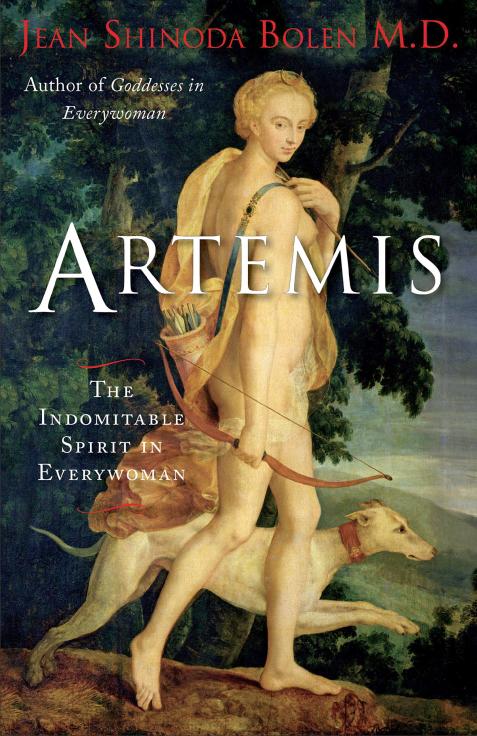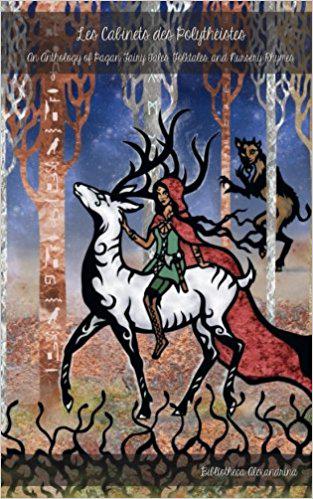Artemis: The Indomitable Spirit in Everywoman
Jean Shinoda Bolen, M.D.
Conari Press, 2014

Review by Barbara Ardinger.
First, historical context—Thirty years ago, when Bolen wrote Goddesses in Everywoman, spiritual feminism (aka feminist spirituality) was on a steep upward flight. Whether we saw Artemis, Athena, Hestia, Hera, Demeter, Persephone, and Aphrodite as true goddesses or as archetypes, we wanted to identify with them and live more divine lives. As our high priestess Gloria Steinem wrote in the foreword, “The highest value of [Goddesses in Everywoman] lies in the moments of recognition it provides … moments of ‘Aha!’: that insightful second when we understand and internalize … [and take] one step further to an understanding of, ‘Yes, that’s why’” (Goddesses in Everywoman, p. xi). We devoured this book as we also devoured Bolen’s succeeding books.
And now—Tons of Goddess books were being published back then. It was the beginning of a great movement. Today it’s a new generation, and we’re seeing fewer such books. This may be because our daughters know more than we did at their age. Bolen opens this new book by defining “indomitable.” It comes from the Latin in + domitare: “to tame; incapable of being subdued or tamed” (p. ix). She then refers to the strong young female heroes (heras) like Katniss Everdeen in The Hunger Games trilogy, Lisbeth Salander in The Girl with the Dragon Tattoo, even—Goddess help us!—Anastasia Steele, that witless participant in sexual abuse in Fifty Shades of Grey. Back in the olden days, Bolen reminds us, our primary hera was Jo March in Little Women, published in 1868 but beloved by generations of girls who wanted something more than sappy novels about modest maidens.
Who is our new mythological and possibly archetypal hera? Bolen says it’s Atalanta, a figure from Greek mythology. She is the newborn daughter of a king who wants a son and orders her thrust out into the wilderness to die. The baby is rescued (possibly by Artemis) and brought up by a mother bear. She grows up strong and beautiful, joins the hunt for the fearsome Calydonian Boar and shoots it in the eye. Prince Meleager then kills it, and they go off into the wilderness to live together until he is killed. Now Atlanta goes home to her father and says she’ll marry the man who can beat her in a foot race, which Prince Hipponemenes (from the next kingdom over) does by throwing golden apples on the road to distract her. They fall in love. The story of Atalanta is Chapter 1 of Bolen’s new book. Myths like Atalanta’s, she says, “have the power of collective dreams and fascinate us because the themes in them are ours to inhabit or to observe” (p. 12).
Although Conari/RedWheel/Weiser needs to hire more competent editors (who can, for example spell Boeotia correctly and understand that a tabula raza is not a tabula rasa), Bolen’s new book is worth reading as she relates every aspect of the Atlanta myth and its context to the inner and outer lives of modern women (and some men). In Chapter 2, she writes about her nights as a Girl Scout camping in the wilderness under the stars. She also writes about the unfortunate habits of patriarchy, one of which is fathers who sell their daughters into marriage. Throughout the book, she tells stories about real women, some of them her patients, others authors like Cheryl Strayed who hiked the Pacific Crest Trail (though Bolen wrote the book before Reese Witherspoon made the movie).
In Chapter 4, “The Hunt for the Calydon Boar,” Bolen describes this famous hunt in the wilderness. Just as Zeus hurled thunderbolts and Poseidon unleashed earthquakes and floods to express their anger, Artemis felt insulted enough to send the huge, ferocious boar to ravage the Greek kingdom. The anger of Artemis happens in modern life, too:
When a woman with a cause becomes so outraged that she is out of control and can’t see that this is damaging both her cause and herself … she has been taken over by the Calydon boar. She doesn’t care who or what her words or actions hurt. … [S]he acts as an avenger of injustice who brings retribution. … She will get even! Her Calydon boar anger grows out of all proportion (p.54).
Scary stuff! Bolen also sees the Boar (both metaphorically and Jungially) as a destructive force of nature, which can include deforestation and death and drying. Yes, destruction happens. Like Atalanta after Meleager’s death, we end up in our own private, usually inner, wilderness after disasters crash into our lives. The wilderness is also the opening topic of Chapter 5. It’s the “metaphoric landscape … where you are in your life when you are in between one major phase or identity and the next. It’s a time when you make your own way, when you do not know what will come next or how you will change” (p. 69).
Bolen uses Chapter 6 and the footrace in which Hippomenes throws the golden apples on the road to distract Atalanta to write about Artemis-identified women who run today, either as exercise or for causes. She assigns meanings to the three golden apples. Apple #1 represents “awareness of time passing.” Apple #2 represents the “awareness of the importance of love.” Apple #3 represents the “awareness of the urge to create.” There are psychological lessons in all of this, of course, as there are in the remaining chapters. Chapter 9, “Free to Be You and Me,” she writes, “fits the intention of this book. Myths and stories come most alive when there is a corresponding active archetype in us” (p. 183). As in the earlier chapters, Bolen refers to present-day girls and women as well as Greek myths to show how we can indeed find our inner goddess and be free to be our best selves. These are good lessons.



